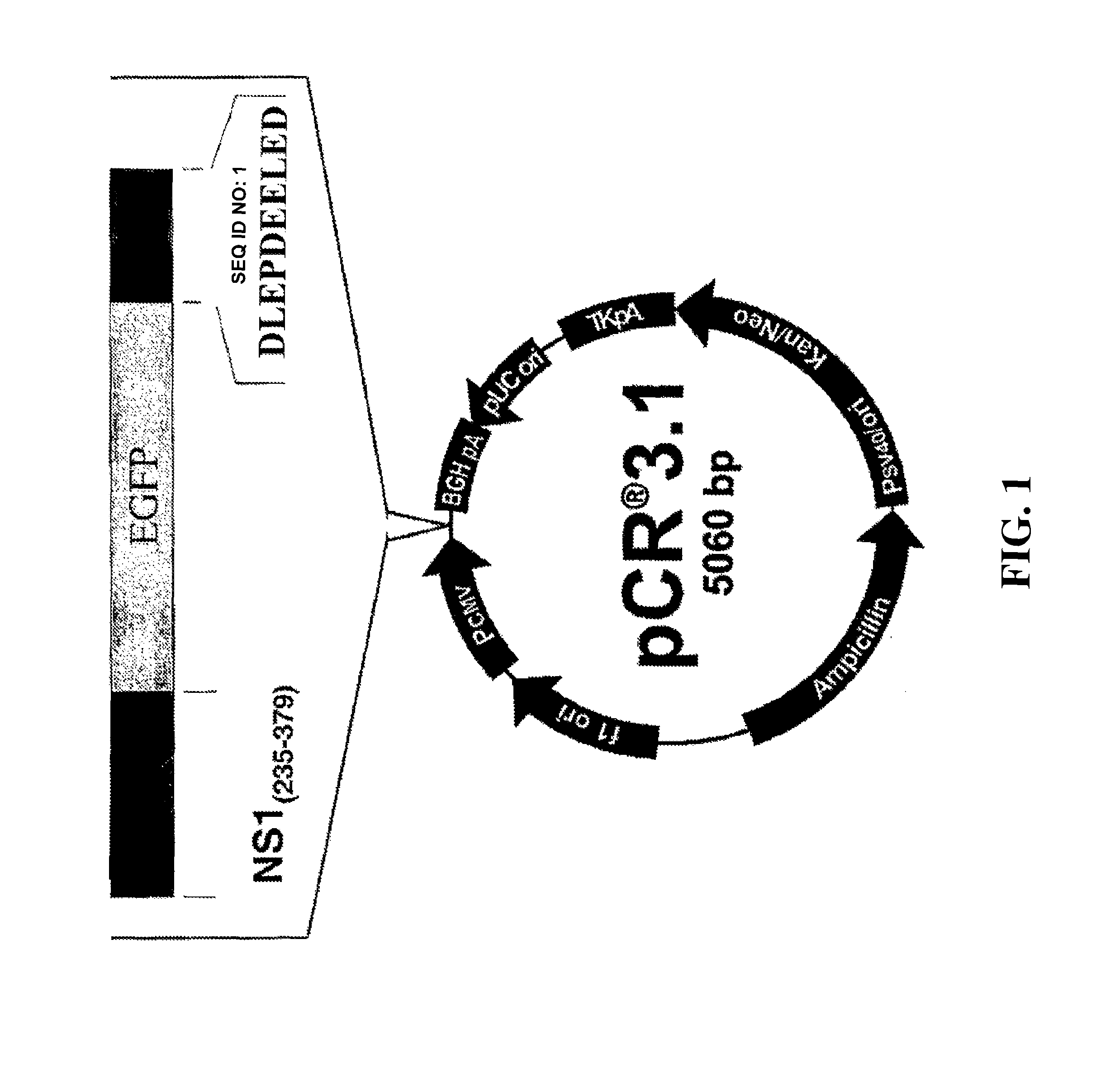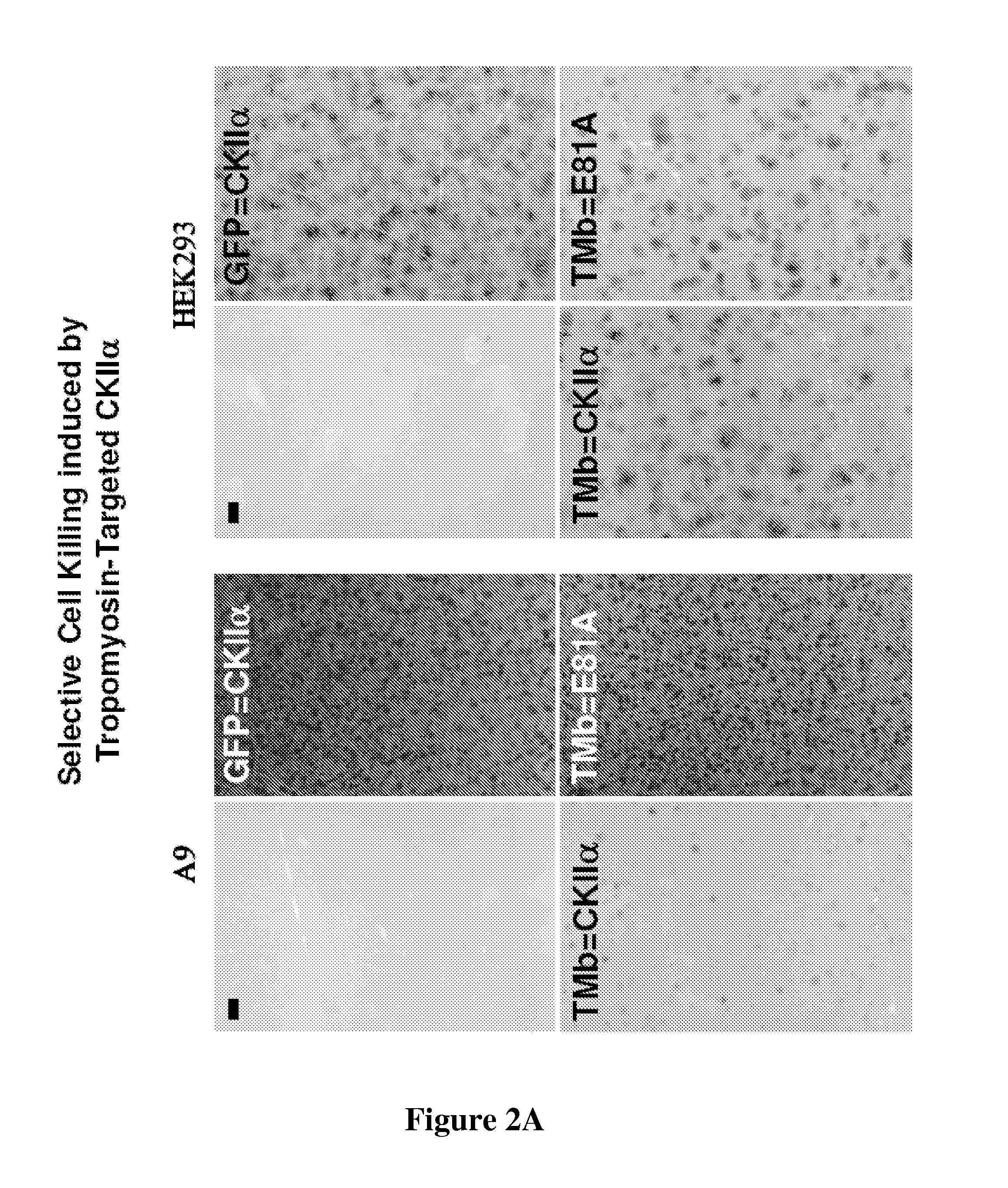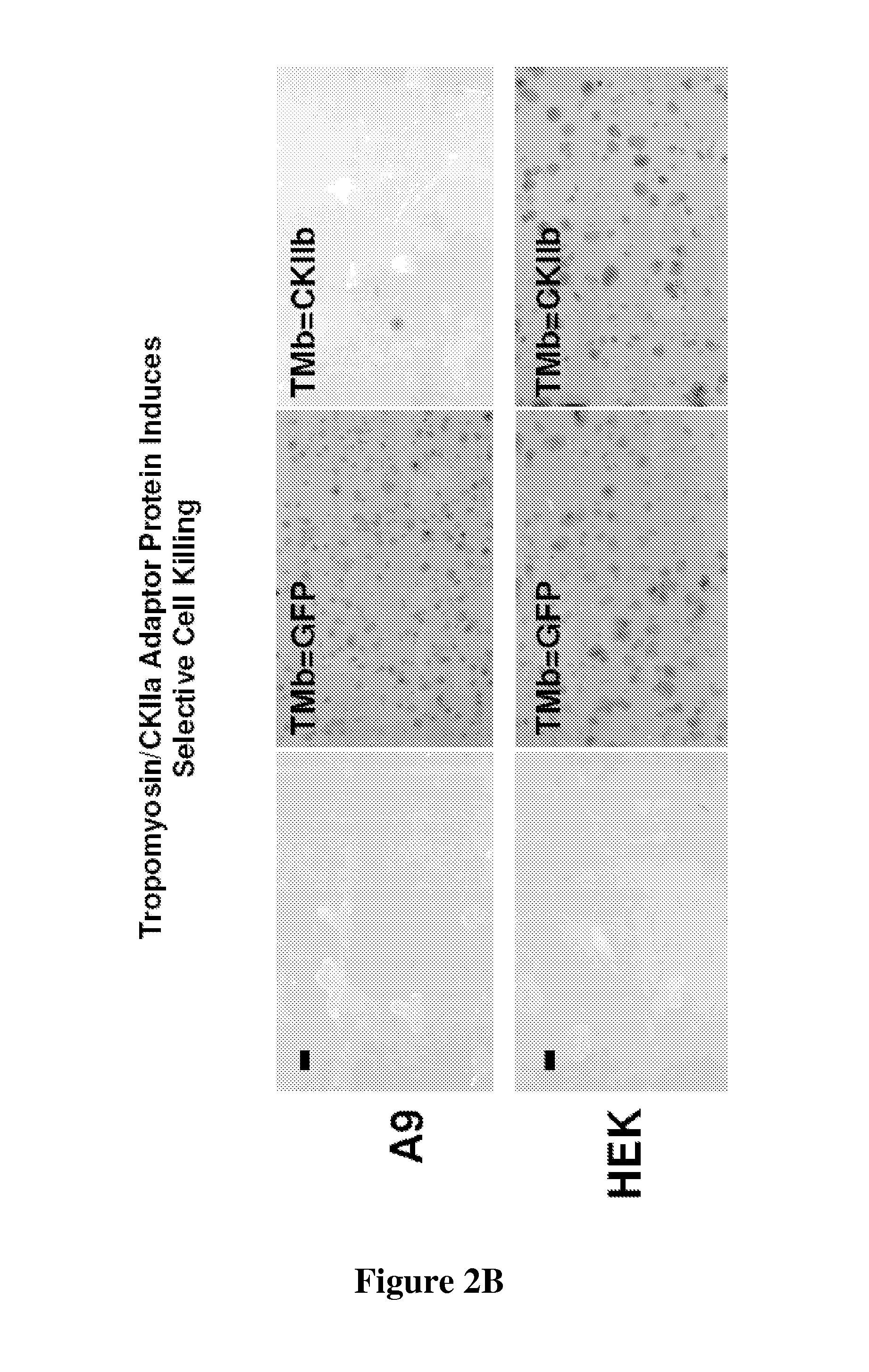Polynucleotide encoding a fusion polypeptide suitable as cytotoxin
a cytotoxin and polypeptide technology, applied in the field of fusion polypeptides, can solve the problems of lack of proficient targeting, low detection efficiency, and relatively high dose requirements, and achieve the effect of strong regulation
- Summary
- Abstract
- Description
- Claims
- Application Information
AI Technical Summary
Benefits of technology
Problems solved by technology
Method used
Image
Examples
example 1
Generation of Fusion Polypeptide Constructs for Testing Putative Oncotoxins for Their Effects on Mammalian Cells
[0045]Given the supposition that NS1 works as a scaffold protein, connecting the catalytic subunit of casein kinase II (CKIIα) to tropomyosin, artificial peptides were designed harboring the tropomyosin binding region of MVM NS1 and connecting either CKIIα(or variants thereof) or just a known CKIIαbinding site (FIG. 1). PCR-derived fragments composed of a tropomyosin binding site (TMB) derived from the parvovirus MVMp NS1 protein (amino acids 235 to 379 of SEQ ID NO: 11), the stabilizer polypeptide EGFP derived from pEGFP (Becton Dickinson, Heidelberg), and either a casein kinase IIαbinding site (derived from CKIIβ: DLEPDEELED; SEQ ID NO: 1) or the functional casein kinase II catalytic subunit CKIIα(NCBI L15618). (CKIIB) were cloned directly into pCR3.1 (Invitrogen, Karlsruhe), due to 3′adenosinetriphosphate overhangs generated by Taq-polymerase (see Annex 1). EGFP, an in ...
example 2
Toxicity Assays
[0047]Colony formation inhibition assays were performed with the constructs described in Example 1. A9 or HEK293 (2×105 cells per 25 cm2) were transfected with 10 μg plasmid DNA using 25 μl lipofectamin in DMEM without serum according to the manufacturer's conditions (Invitrogen). After 5 hr incubation transfection medium was replaced with DMEM containing 10% FBS and cells were grown for additional 48 h in absence of G418 before subdividing into 150 cm2 plates where transfected cells were selected for by addition of 400 μg / ml G418 (SIGMA, Taufkirchen). Growing colonies were fixed and stained according to McCoy after two to three weeks growth under selective pressure. Two representative experiments are shown in FIG. 2a and FIG. 2b. While expression of the two effector proteins (TMB=CKIIα (FIG. 2a) and TMB=CKIIB (FIG. 2b) allowed only few colonies to be generated in A9 cells in comparison to the control peptides, almost similar transfectants were generated in a low pass...
example 3
Generation of Semi-Synthetic Toxins by Chimeric PCR
[0049]Fusion constructs are generated by consecutive PCR reactions using overlapping primer pairs. In a first reaction the individual PCR-elements generated: TMB(GFP): Lefthand primer A 5′-GATATCCCATGGGGAAAACTAACTTTTTAAAAGAAGGCGA-3′ (SEQ ID NO: 2) with righthand primer B: 5′ -TCCTCGCCCTTGCTCACCATATGGCAACTTAACATAGGT-3′ (SEQ ID NO: 3) using pdBMVp (Kestler et al,1999) as a template. (TMB)-GFP.CKIIB: C: 5′-ACTATGTTAAAGTTTGCCATATGGTGAGCAAGGGCGAGGA-3′ (SEQ ID NO: 4) with D: 5′-GCGGCCGCTCTAGATTAATCTTCCAATTCTTCATCGGGTTCCAAATCCCTCC GATGCTTGTACAGCTCGTCCATGCCGAG-3′ (SEQ ID NO: 5) using pEGFP (Becton Dickinson) as a template. GFP-(CKIIα): E: 5′-CCCGGGATGGTGAGCAAGGGCGAGGAGCTGTTCACCGGGG-3′ (SEQ ID NO: 6) and F: 5′-TCCTCGCCCTTGCTCACCATCTGCTGAGCGCCAGCGGCAGG-3′ (SEQ ID NO: 7) using pEGFP as a template. (TMB)-GFP-(CKIIα): Primer A and F using pEGFP as a template (GFP)-CKIIα(wt or E81A): G: 5′-CTGCCGCTGGCGCTCAGCAGATGGTGAGCAAGGGCGAGGA-3′ (SEQ ID NO: 8...
PUM
 Login to View More
Login to View More Abstract
Description
Claims
Application Information
 Login to View More
Login to View More - R&D
- Intellectual Property
- Life Sciences
- Materials
- Tech Scout
- Unparalleled Data Quality
- Higher Quality Content
- 60% Fewer Hallucinations
Browse by: Latest US Patents, China's latest patents, Technical Efficacy Thesaurus, Application Domain, Technology Topic, Popular Technical Reports.
© 2025 PatSnap. All rights reserved.Legal|Privacy policy|Modern Slavery Act Transparency Statement|Sitemap|About US| Contact US: help@patsnap.com



